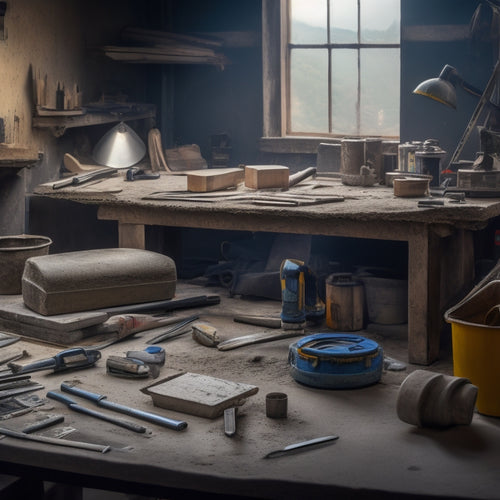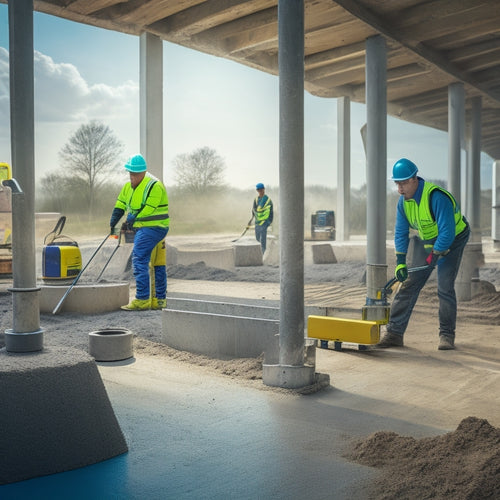
3 Best Tools for Concrete Block Wall Repair
Share
When tackling concrete block wall repairs, you'll need reliable equipment to guarantee a strong and lasting fix. For drilling, invest in a rotary hammer drill or hammer drill paired with tungsten carbide-tipped masonry bits. Next, prepare for sealant application with a caulk gun or trowel, and perfect the smoothing technique to achieve a seamless finish. Additionally, consider reinforcement and anchoring systems, such as rebar and epoxy or fiber reinforcement, to strengthen your walls. With these top tools in your arsenal, you'll be well-equipped to tackle even the most challenging concrete block wall repairs, and by understanding these fundamentals, you'll be able to tackle even more complex projects.
Key Takeaways
- A reliable drill, such as a rotary hammer drill or hammer drill, is essential for concrete block wall repair.
- Masonry bits with tungsten carbide tips are specifically designed for drilling into concrete and provide durability.
- A caulk gun or trowel is necessary for applying sealants, depending on the type and size of the repair.
- A level or straightedge is required for smoothing sealant edges to achieve a seamless finish.
- Anchoring systems, such as rebar and epoxy or fiber reinforcement, are crucial for ensuring wall stability and preventing further damage.
Essential Drilling Equipment Needed
When tackling a concrete block wall repair, having the right drilling equipment is vital to ensuring a successful and efficient process.
You'll need a reliable drill that can handle the demands of drilling into concrete. A rotary hammer drill or a hammer drill is ideal for this task, as they provide the necessary power and control.
When it comes to drill bit types, you'll want to use masonry bits specifically designed for drilling into concrete. These bits have a tungsten carbide tip that can withstand the hardness of concrete and are available in various sizes and shapes.
The most common types are twist bits, step bits, and core bits, each suited for different drilling techniques and applications.
Mastering various drilling techniques is essential for effective concrete block wall repair. You'll need to know how to apply the right amount of pressure, maintain a steady speed, and use the correct drilling angle to avoid damaging the surrounding concrete.
Sealant Application and Smoothing
You've successfully drilled into the concrete block wall and prepared the surface for repair. Now it's time to apply a sealant to fill in the gaps and cracks.
When selecting a sealant, choose from a range of types, including epoxy-based, polyurethane-based, or acrylic-based sealants, each suited to specific repair needs. Epoxy-based sealants offer high bonding strength, while polyurethane-based sealants provide flexibility and resistance to movement. Acrylic-based sealants are ideal for smaller, non-structural repairs.
When applying sealant, use a caulk gun or trowel, depending on the sealant type and repair size. Verify the surface is clean and dry, and apply the sealant in a continuous bead, filling the gap or crack completely.
Use a level or straightedge to smooth out the sealant, feathering it out towards the edges to create a seamless finish. For larger repairs, use a putty knife or trowel to spread and smooth the sealant.
Allow the sealant to cure according to the manufacturer's instructions before proceeding with further repairs or finishing coats.
Reinforcement and Anchoring Systems
Three key components of a concrete block wall repair are reinforcement, anchoring, and surface preparation.
You'll need to verify that your wall is stable and secure before applying any sealants or smoothing out the surface.
Reinforcement techniques are used to strengthen the wall and prevent further damage, while anchoring methods secure the wall to the surrounding structure.
When it comes to reinforcement and anchoring systems, you have several options to choose from.
Here are three common methods:
-
Rebar and epoxy injection: This method involves drilling holes into the wall and injecting epoxy to fill any cracks or voids. Rebar is then inserted into the holes to provide additional strength.
-
Fiber reinforcement: This technique involves applying a fiber-reinforced polymer (FRP) to the wall surface. The FRP is bonded to the concrete using a specialized adhesive, providing additional tensile strength.
-
Anchoring systems: These systems use mechanical anchors or adhesive anchors to secure the wall to the surrounding structure. This is particularly important in areas prone to seismic activity or high winds.
Frequently Asked Questions
Can I Repair a Concrete Block Wall With a Structural Integrity Issue?
You'll need to assess the wall's structural integrity before attempting repairs, as a flawed repair can exacerbate the issue; consider hiring a professional to evaluate the damage and recommend appropriate repair methods to guarantee a safe and effective fix.
How Do I Prevent Further Damage During the Repair Process?
When tackling a concrete block wall repair, you'll first conduct a thorough damage assessment, identifying affected areas and extent of damage, then create a detailed repair planning strategy to prevent further damage during the process.
What Safety Gear Is Necessary for Concrete Block Wall Repair?
When working on concrete block wall repair, you'll need essential safety gear, including safety goggles to shield your eyes from debris and dust, and protective gloves to prevent cuts and abrasions on your hands.
Can I Use Standard Cement for Concrete Block Wall Repair?
As you traverse the repair environment, imagine a delicate canvas - will standard cement be the gentle brushstroke or harsh splatter that ruins the masterpiece? Opt for specialized alternatives, like epoxy-based products, to guarantee a strong, enduring bond, and employ best repair techniques for a flawless finish.
How Long Does a Concrete Block Wall Repair Typically Take to Complete?
You'll find that concrete block wall repair timeframes vary depending on the extent of damage and chosen wall repair techniques; generally, minor repairs take a few hours, while extensive repairs can take several days or even weeks to complete.
Conclusion
You've made it to the finish line! With these three powerhouse tools in your arsenal, you'll be able to tackle even the most intimidating concrete block wall repairs with ease. Your drill will pierce through concrete like a hot knife through butter, your sealant will bond with the precision of a surgeon's scalpel, and your reinforcement systems will anchor with the unyielding grip of a titan. Get ready to conquer the world, one concrete block at a time!
Related Posts
-

3 Best Hand Tools for DIY Concrete Construction
When tackling a DIY concrete construction project, you'll need three essential hand tools to achieve a professional-l...
-

Best Tools for Concrete Restoration and Repair
When tackling concrete restoration and repair projects, you need a range of reliable tools to achieve professional-gr...
-

What Tools Ensure Precise Concrete Leveling Results
You need a range of specialized tools to achieve precise concrete leveling results. Laser leveling instruments provid...


